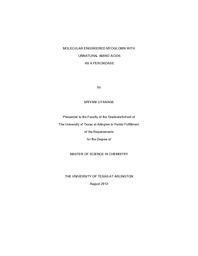
ATTENTION: The works hosted here are being migrated to a new repository that will consolidate resources, improve discoverability, and better show UTA's research impact on the global community. We will update authors as the migration progresses. Please see MavMatrix for more information.
Show simple item record
| dc.contributor.author | Liyanage, Kananke Sriyani | en_US |
| dc.date.accessioned | 2013-03-20T19:12:35Z | |
| dc.date.available | 2013-03-20T19:12:35Z | |
| dc.date.issued | 2013-03-20 | |
| dc.date.submitted | January 2012 | en_US |
| dc.identifier.other | DISS-11798 | en_US |
| dc.identifier.uri | http://hdl.handle.net/10106/11614 | |
| dc.description.abstract | Myoglobin (Mb) has been used as a model system to mimic other biologically important heme proteins like cytochrome P450 due to its ability to prepare mixed ligand complexes with different valencies, such as ferric, ferrous and ferryl species. It has been engineered to perform peroxidase, peroxygenase, monooxygenase and catalase activities. However, previous work on this area has shown that the distal histidine (H64) in the active of wild-type Mb is a critical residue, which destabilizes compound I, the reactive intermediate of the catalytic cycle (a ferryl ð-porphyrin radical cation). Therefore in this study we replaced H64 with a smaller residue, glycine. The expected distance between the new glycine residue and the heme iron center is estimated to be equal to that of cytochrome c peroxidase (CcP). Hence we hypothesized our mutant myoglobin would act as a peroxidase. Also, we mutated the leucine residue at 29th position (L29) into an amber codon for incorporation of an unnatural amino acid [dihydroxy-L-phenylalanine (DOPA) or 3-amino-L-tyrosine (3NH2Tyr)]. . Our L29-DOPA/H64G mutant catalyzed the reaction between thioanisole and H2O2 to form the radical products; biphenyl, diphenyl sulfide and diphenyl disulfide. We report these radical product formations for the first time. Our results show that the unnatural amino acids (DOPA and 3NH2Tyr) in the active site provide novel structural and functional pproperties to Mb. Also we successfully prepared oxycomplexes of L29-DOPA/H64G Mb. Moreover, we successfully immobilized L29-DOPA/H64G Mb on the L-cystine modified Au electrode using EDC (1-Ethyl-3-[3-dimethylaminopropyl]carbodiimide). We report a surface coverage (Ãaverage) of 9.35 x 10-12 mol cm-2, an electron transfer coefficient of 0.503 and a rate of heterogeneous electron transfer of 2.45 s-1 from the Au electrode to the iron center of the immobilized mutant Mb. Also, the immobilized protein carried out the electrocatalysis of ascorbic acid to its oxidized form. Therefore our Au/L-Cys/L29DOPA H64G Mb electrode can be used as a sensor to detect ascorbic acid. | en_US |
| dc.description.sponsorship | Perera, Roshan | en_US |
| dc.language.iso | en | en_US |
| dc.publisher | Chemistry & Biochemistry | en_US |
| dc.title | Molecular Engineered Myoglobin With Unnatural Amino Acids As A Peroxidase | en_US |
| dc.type | M.S. | en_US |
| dc.contributor.committeeChair | Perera, Roshan | en_US |
| dc.degree.department | Chemistry & Biochemistry | en_US |
| dc.degree.discipline | Chemistry & Biochemistry | en_US |
| dc.degree.grantor | University of Texas at Arlington | en_US |
| dc.degree.level | masters | en_US |
| dc.degree.name | M.S. | en_US |
Files in this item
- Name:
- Liyanage_uta_2502M_11798.pdf
- Size:
- 2.018Mb
- Format:
- PDF
This item appears in the following Collection(s)
Show simple item record


